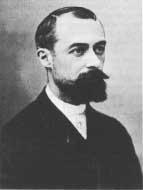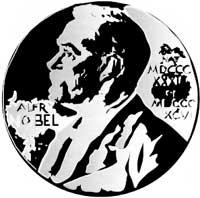Antoine Henri Becquerel
Elhuyar Fundazioa
French physicist born in Paris on 15 December 1852. In the family there were also physicists. Grandfather Antoine Caesar fought against Napoleon's orders and after the defeat of Waterloo, studied piezoelectricity, the pile of two liquids and the photovoltaic stack. Father Alexandre Edmond took care of fluorescence and phosphorescence. He used photographic plates in spectroscopy, analyzing ultraviolet radiation.
Antoine Henri Becquerel began his scientific studies at the Antoine Polytechnic School and then gave them continuity at the Road Engineering School.

In 1892 he entered as a physics professor at the National Museum of Natural History in Paris. In 1894 he was appointed chief engineer of the Department of Bridges and Highways.
Becquerel researched fluorescence and phosphorescence in his father's thread, but in his evolution towards the atomic structure in the nineteenth century. He came across something that would revolutionize the vision of the 20th century.
Roentgen discovered X-rays and Becquerel wanted to check whether or not fluorescent substances emitted. Roentgen discovered the X-rays by the fluorescence they produced.
In 1896 he collected a photographic plate on black paper and left it in the sun with a fluorescent chemical element on top. If sunlight produced fluorescence and fluorescence had x-rays, those rays would reach through the paper to the plate, even if sunlight or ultraviolet light did not reach. Becquerel used uranil and potassium sulfate to form a compound and deposit it onto the collected plate.
The plates were removed and completely wrapped. The radiations crossed the black paper and Becquerel thought that X-rays were produced by fluorescence.
The following days were clouded and Becquerel was nervous. Due to the inclement weather, he had to leave another plate in a drawer with his glass on top. After the days he decided to open the plate. Although it was not in the sun, maybe the glass had some fluorescence and the plate was a little black. Upon opening, however, he discovered that the plate was completely veiled. In the radiation of the compound sunlight had nothing to do with fluorescence either.
Outside the sun, he discovered that these radiations were like x-rays. On the one hand they crossed matter and on the other ionized air. That constant radiation that spread in all directions, Mrs. Curie in 1988 called it “radioactivity”. However, for some years uranium radiation was called Becquerel rays.
In 1899 it was discovered that the radiations could be diverted by the magnetic field. Therefore, I deduced that some of them were partially loaded. In 1900 part negatively charged with cathodic rays (J. J. Thomson found them) proposed that they were fast electrons.

The radiated electrons were transmitted inside the uranium atoms, as Becquerel pointed out in 1901. It was the first time it was stated that the atom was accurate and had its internal structure.
For his discoveries, in 1903 he received the Nobel Prize in Physics with his wife Curie.
In 1908 he was appointed secretary of the Academy of Sciences.
The International System has used the name Becquerel as a radioactivity unit. It is the core activity necessary for a natural nuclear transition per second.
Antoine Henri Becquerel died on 25 August 1908 in Le Croisic (Lower Loire).





